River Profile - Floura and Fauna | |
| Floura and Fauna | Riverscape Features | |
| Visit the main River Returns web site >> | |
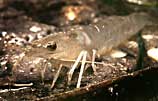 © South Florida Water Management District |
White ShrimpWhere the oceans meets the lower St. Johns River is an estuary; in fact, it's Florida's largest at 2,777 square miles. White shrimp, such as this one, spawn offshore but use the river's lower basin as a nursery to mature. Commercial and sport shrimpers operate between Jacksonville and Palatka. |
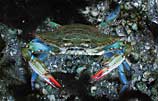 |
Blue CrabThe blue crab is a St. Johns inhabitant more commonly associated with oceans than rivers. During warmer months, blue crabs move up and down the river, reaching as far south as Lake George. They spawn in cooler months in the lower basin of the River, near the Atlantic Ocean. |
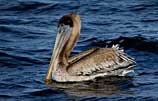 |
Juvenile Brown PelicanOne of Florida's most widely recognized birds, the prehistoric-looking brown pelican, can be found wintering inland on the St. Johns River, as far south as Lake George. This juvenile floats patiently next to a fishing boat, waiting for a handout. |
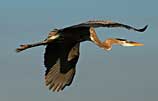 © Jill Heinerth |
Great Blue HeronThe great blue heron is one of the river's icons, found throughout the entire length of the St. Johns. With its long legs, six-foot wingspan, and s-curved neck, this wading bird has an impressive presence in both water and sky, but altogether weighs only five pounds. |
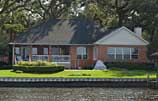 |
Nesting site, Homo SapienHomo sapiens are particularly thick in the lower St. Johns basin. Their habitat too often is characterized by removal of natural undergrowth and replacement with non-native grasses requiring fertilizers and pesticides that are harmful to the river, as well as natural flora and fauna. |
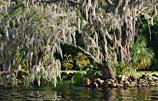 |
Spanish MossA ubiquitous St. Johns River plant is the epiphyte commonly known as Spanish Moss. This lacy gray tangle commonly drapes from the limbs of hardwoods and evergreens along the river. Early citrus shippers used moss as a packing material to protect cargo from bruising. |
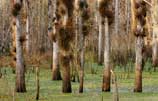 |
Wooded WetlandSome sections along the banks of the St. Johns are high and dry enough to support hardwood forests; much of the river is surrounded by wooded wetland, however. Here, epiphytes grow on the trunks of tupelo and other trees, such as cypress, that like to get their feet wet and therefore thrive in a swamp habitat. |
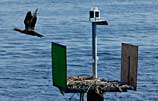 |
Double-Crested CormorantAlong the river's length, there's hardly a buoy, snag, or in this case, channel marker, that remains unoccupied for very long by cormorants. These birds are swift flyers and agile swimmers, diving below the surface to catch small fish. |
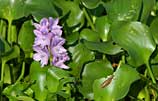 |
Water HyacinthNot long after its well-intentioned introduction to the St. Johns, just south of Palatka in the late 1800s, the prolific water hyacinth formed massive mats that posed navigational nightmares for boats. Florida still spends millions annually on pesticides to control this impossible-to-eradicate invasive, aptly dubbed a "lovely plague." |
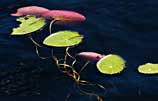 |
Lily PadsThe whitish guano of cormorants -- a natural source of nitrogen in the St. Johns River -- is spattered on the leaves of this yellow water lily, one of the "good guys" of aquatic vegetation. The runaway growth of exotics such as hydrilla and hyacinths can crowd out these natives. |
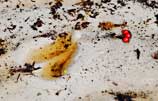 |
Deer PrintThe tangled forests covering the banks and hammocks of the St. Johns River provide habitat for a diverse range of mammals, ranging from the stealthy bobcat to lumbering black bear. Here, tannic St. Johns River water fills the sandy riverside print of a white-tailed deer that recently quenched its thirst. |
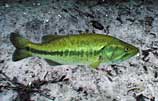 |
Largemouth BassThe largemouth bass is one of the top draws of sportsmen to the St. Johns River. There are lunker bass in excess of 10 pounds that hang out in and around Lake George, a fisherman's dream destination. This largemouth bass swims in the clear waters of Silver Glen Spring, a tributary of the St. Johns. |
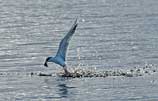 |
Common TernNear the Georgetown Marina a common tern dives and dips with precision into the tannin ripples of the St. Johns River, securing for itself a tasty fish dinner. |
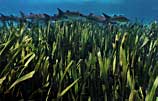 |
EelgrassAquatic plants like eelgrass, which oxygenate the water through photosynthesis, play a vital role in the St. Johns by providing food and shelter for numerous species. Here, in the Silver Glen Spring tributary, mullet swim above an eelgrass bed. Though darker with tannins, the St. Johns supports healthy eelgrass colonies, too. |
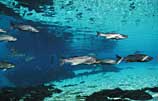 |
Striped BassNormally associated with a saltwater environment, striped bass are found in the St. Johns as far inland as Lake George, the southernmost extent of tidal influence on the river. Here, striped bass circle the springhead at Silver Glen, seeking and finding cool refuge from the river's warmer summer temperatures. |
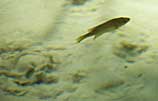 |
Bream and Sand BoilThe term "bream" is the common collective name for a number of Florida's panfish, including bluegills and sunfish. Here, near Silver Glen Spring, a bream hovers above a "sand boil." A small spring just below the sand surface keeps sand grains percolating, forming a "boil" of sand. |
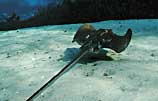 |
StingrayIn the clear waters of Silver Glen Spring, an Atlantic stingray cruises the sand bottom in search of small crustaceans to eat. Common throughout the St. Johns River system, the stingray is a saltwater species that, uniquely enough, makes its home year round in the river. |
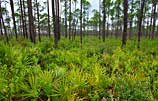 |
Longleaf Pine ForestThe Ocala National Forest, a huge expanse of longleaf pines, saw palmetto, and scrub, lies on the east bank of the St. Johns River, affording a protective buffer from development in the middle basin area. This area is prime habitat for bald eagles, among other species. |
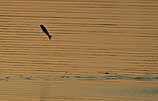 |
Leaping MulletIn the quiet of an early morning or late afternoon, the St. Johns River comes alive with leaping mullet, their distinctive splashes punctuating the silence in every direction at once. It's difficult to catch a mullet -- especially with a camera -- as the fish graze on aquatic grasses. |
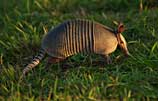 |
ArmadilloThe comical appearance of an armadillo, the closest relatives of which are sloths and anteaters, provides an unexpected distraction from sightings of the more common St. Johns creatures such as mosquitoes, gators, and wading birds. |
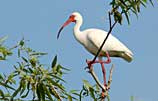 © St. Johns River Water Management District |
IbisOnce numbering in flocks of tens of thousands, the white ibis is considered a threatened species because of over-hunting and habitat destruction. There's probably no better place in the world to see great numbers of them than the St. Johns corridor, where their appearance is fairly common. |
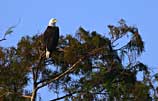 |
Bald EagleThe best viewing spots on the river for bald eagles occur in the middle basin of the St. Johns, particularly around the Ocala National Forest and Lake George. This majestic raptor, a keystone species at the top of the food chain, has made a remarkable comeback in Florida, particularly along the St. Johns. |
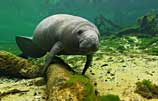 © Karst Productions, Inc. |
ManateeA manatee in Blue Spring Run approaches an underwater cameraman with seeming curiosity. Though plentiful during the winter in Blue Spring Run, where they seek a warm water spring refuge from the colder St. Johns River, the manatee population as a whole is under pressure from habitat loss and boat strikes. |
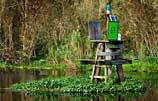 |
Floating Water PlantsA thick floating mat of aquatic plants, including water hyacinth and dollar weed, clings to the pilings of a channel marker. Invasive vegetation such as hyacinth and hydrilla -- a southeastern Asia native used in aquariums - are common and a pervasive problem along the river. |
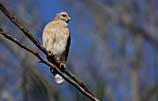 |
Red-Shouldered HawkThe cry of the red-shouldered hawk can be heard up and down the length of the St. Johns. It's one of a number of raptors that call this river home. |
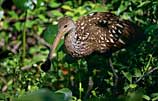 © St. Johns River Water Management District |
LimpkinThe limpkin, a solitary wading bird, once thrived in the marshes and swamps of the St. Johns River; its numbers are less plentiful now because of habitat loss and diminished availability of its primary food source, the apple snail. The limpkin's bloodcurdling shriek has been likened to a woman's scream. |
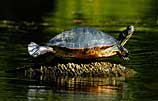 |
Red-bellied turtle"Cooters" are what the locals call turtles. Up and down the length of the St. Johns and tributaries such as the Wekiva, red-bellied turtles wile away their days balanced on logs and catching tropical rays. |
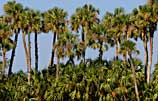 |
Sabal PalmsThe sabal palm is Florida's state tree; it's also known as the cabbage palm. A common feature of the St. John River basins, it's especially prolific in the southern regions of the river. |
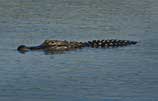 |
AlligatorAlligators are a common site throughout the St. Johns River system, but some places have a greater concentration of these toothy reptiles than others Gators are estimated to number around 10,000 in Lake Jesup, for instance. |
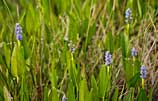 |
Pickerel WeedAs the river's personality changes from a single discernable main stem into a braid of channels, it flows through grassy marshes that bloom with aquatic plants such as the pickerel weed. |
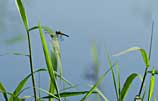 |
DragonflyThe St. Johns basin is aflutter with insects ranging from iridescent-winged dragonflies to colorful butterflies, but it's the mosquito that reigns supreme here, in terms of numbers and reputation. |
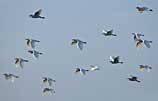 |
Cattle Egret FlockThe north-flowing St. Johns River is a flyway for lots of flocks, everything from egrets (pictured here) to cranes. Thus it is a birdwatchers' paradise. Common as they are now, egrets were almost hunted out of existence back when the millinery industry paid top dollar for fashionable feathers. |
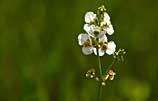 |
Common ArrowheadThe showy bloom of the common arrowhead rises head and shoulders above other aquatic plants in the marshes of the St. Johns' headwaters region. |
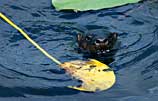 |
River OtterThe sighting of a river otter on the St. Johns is enough to make even the crustiest old steamboat captain want to stop and admire their sleek swimming, if not join in their frolicking fun. Otters are found from the headwaters in the south to the tributaries of the northern parts of the river. |
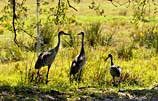 |
Sandhill CranesDuring cold months, the migratory sandhill crane finds a hospitable winter habitat in the marshy headwaters region of the St. Johns River. Sometimes a rare and solitary whooping crane can be seen hanging out on the periphery of a noisy sandhill flock. |
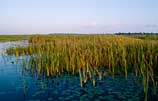 © St. Johns River Water Management District |
CattailsAlthough the ubiquitous cattail looks perfectly at home in the St. Johns River landscape, it actually doesn't belong. An indicator of high nutrient levels in the water, cattails are symptomatic of a system that's out-of-balance; they overtake native aquatic grasses that serve as nurseries for fish. |
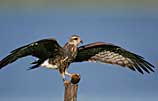 © Arthur Morris - BirdsAsArt.com |
Everglades Snail KiteA hawk-like snail kite perches with a tasty apple snail in its talons. Loss of sawgrass habitat and wildly manipulated water levels caused a dangerous decline in its population. Snail kites are reappearing in the headwaters of the St. Johns, a hopeful sign of the river's restoration. |
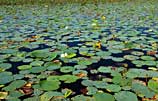 |
Lily PadsNear the headwaters of the St. Johns, the drainage ditches have been filled and pastures restored to wetlands. As a result, yellow-flowered lilypads bloom with abandon where cattle once grazed, providing habitat and food for countless insects, crustaceans, fish and birds. |
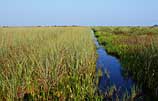 |
Sawgrass MarshAn airboat trail cuts a narrow swath through acres upon acres of sawgrass marsh. This rare but vital remnant of sawgrass thrives just outside of the Everglades, in the headwaters region of the St. Johns River. |
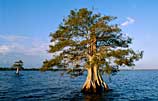 © St. Johns River Water Management District |
Bald CypressHuge and ancient bald cypress were wantonly clear-cut by loggers at the turn of the century. Trees such as this one, with its feet submerged in the tannin water, are now protected on public lands throughout the St. Johns River system. |
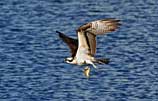 |
OspreyCommon throughout much of the river basin, osprey are particularly plentiful in and around Blue Cypress Lake where as many as 100 nesting pairs come to build impressive twig nests which get bigger each successive season. Here, the raptors' cries are as constant as the lapping of water against cypress. |
River Profile
The River Returns
Stories of the Great St. Johns
The River Returns web documentary, Copyright © Fusionspark Media, Inc. All Rights Reserved.
All Photos © 2005 Russell Sparkman/Fusionspark Media, Inc., unless otherwise noted.
All Photos © 2005 Russell Sparkman/Fusionspark Media, Inc., unless otherwise noted.
